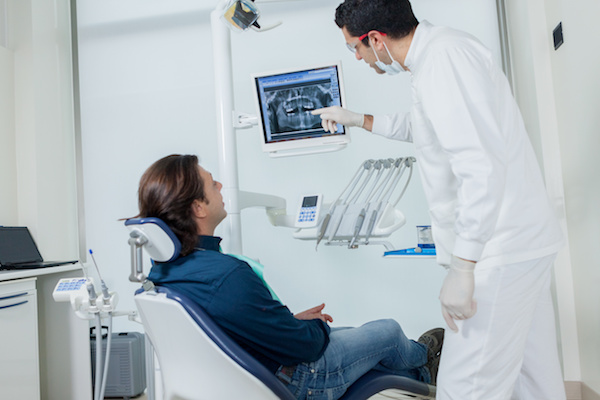
How Did I Get Gum Disease?
Your first indication of gum disease may be blood on your toothbrush bristles. Gingivitis, an early form of gum disease, usually presents easily identifiable symptoms, such as red, swollen gum tissue or gums that bleed as you brush your teeth. In some cases, you may not notice the signs of gum disease on your own. In such instances, you may receive the diagnosis from your dentist. Regardless of how you discover that you have gum disease, once you are diagnosed, you may wonder how it developed.
Gum Inflammation
Gum disease often begins as gum tissue inflammation. Much of the inflammation can come from plaque. When good oral hygiene is not practiced regularly, Plaque can build up on the teeth. The plaque, which is a combination of food particles and bacteria in your mouth, can inflame the gums due to bacterial acid.
As bacteria within the plaque feed on food particles, acid is released. This acid, which also causes tooth decay, inflames the gums.
Careful brushing and flossing can help remove large amounts of plaque. However, if it remains in place, plaque can harden into tartar. Tartar, which can’t be brushed away with your toothbrush, must be scraped away using professional dental tools. As tartar builds up, its porous structure invites even more plaque to accumulate in its crevices to cause more gum and tooth issues.
Developing Gingivitis
As the oral bacteria within the plaque continue to inflame your gums, the gingival tissue swells, reddens and bleeds more easily.
Although gingivitis is considered a mild type of periodontal disease, it can quickly progress if proper gum health is not restored through regular flossing and brushing. In addition to at-home hygiene efforts, it is important to have the tartar cleaned from your teeth at least twice a year by a dentist or hygienist.
Developing Periodontitis
Periodontitis is a more severe form of gum disease. Symptoms of periodontitis include gum recession. The gums actually pull back from the teeth, causing the teeth to appear elongated. In addition, at this stage of periodontal disease, pockets or gaps form around the teeth. These pockets within the gums can harbor oral bacteria that cause the gums to become infected.
As the infection within the gums expands, the bacterial toxins that are released by the microbes can start to deteriorate the jawbone and soft tissues that keep the teeth firmly in position. If periodontitis is not reversed, the jawbone may begin to shrink. In addition, gum tissue may be destroyed, and teeth may loosen and eventually fall out or require extraction.
To treat periodontitis, a deep cleaning and root planing may be required. Deep cleanings remove tartar from below and above your gumline. Root planing eliminates rough spots on the roots of your teeth, where bacteria can collect.
Are there factors that make you more susceptible to gum disease?
Tobacco usage. Whether the product of choice is smokeless tobacco or a cigarette, tobacco usage can cause gum problems. Irritants within the tobacco inflame the gums. If smokeless or chewing tobacco is used, the abrasive texture of the product can further irritate the gum tissue. Additionally, smoking can impair the oxygen flow and blood circulation to the gums.
Diabetes. High levels of blood sugar can cause an increase in the bacterial population within your mouth. As a result, there may be more bacterial acid released to incite gum disease. In addition, people who suffer from diabetes are more likely to develop gum infections.
Pregnancy. Due to the hormonal changes that occur during pregnancy, pregnant women may have an increased chance of developing gum disease.
Prescription medications. Many medicines cause dry mouth. As the amount of saliva in the mouth is reduced, there may be an increase in oral bacteria and plaque.
What are some of the key indicators of gum disease?
Common symptoms of periodontal disease include the following:
- Bleeding gums
- Swollen or red gingival tissue
- Pain while chewing
- Persistent bad breath
- Dental sensitivity to heat and cold
- Teeth that are loose within their sockets
- A receding gum line
If you are experiencing symptoms of gum disease, it is important to reverse the condition as soon as possible. Schedule an appointment with our office for treatment.